Looking for a traditional, classic knife design made with the best of modern materials? Check out these newcomers.
by Leon Pantenburg
I was not paid to do this review. KnivesShipFree,com is a SurvivalCommonSense.com sponsor and loaned me several of the knives mentioned, and they will be returned when I’m done testing them. The other knives I bought or already owned.
Scandinavian. Saex. Roach belly. Hudson Bay Camp Knife. Nessmuk. Kephart.
Mention these classic cutlery designs to a knife aficionado, and they’ll probably know what you’re talking about. And there’s a reason some designs are called classics – they have proven themselves time and again.
But while many people like the old-style designs and would like to use them, they wish these classics were available in modern materials.
Luckily for us history types, several companies adapt traditional designs to modern materials. Here are some classics from Bark River Knives, L.T. Wright, C.T. Fischer and Lon Humphrey that can scratch your history itch while providing a quality knife with a proven design.
Here are some areas where modern materials meet classic designs.
Steel: I’m not a metallurgist, but I know what works for me. I like A-2 steel a lot. I used a BR Sahara and Kalahari Hunter on deer last season, and the A-2 steel holds a razor edge. I used each knife to completely gut, skin and quarter a whitetail, and both were still shaving sharp when the job was over.
CPM 3V is another of my favorites. My BR Sportsman in that steel is my most-used kitchen and fillet knife.
A-2 and 1095 take a nice patina, and it’s easy to make that classic knife look even more authentic with a forced vinegar/lemon juice patina. (Forcing the patina is easy.)
Any of these modern steels are an improvement over the original hand-forged steels that varied wildly in quality
Handle: Bone and wood were some of the most commonly-used handle materials in the old time knives. But they might not necessarily fit your hand all that well. My experience is that modern micarta and properly treated wood handles tend to get almost tacky when wet. In one instance, I had to dip my hand and the BR Kalahari into the chest cavity of a downed deer. The heart-lungs shot had resulted in a puree of blood and tissue. The micarta didn’t get slippery. Same with the desert ironwood on my Sahara.
Blade belly: Since a large part of the knife’s job was to skin and process big game animals, the frontiersman, farmer or settler needed an effective skinning knife. The curve of the blade that does all the work is called the “belly.”
Sheath: While you can get a “tacticool” kydex sheath for any of these blades, they don’t look right. All these modern classic designs come with a good-looking, sturdy leather sheath.
In a vaguely chronological order by appearance in history, here are some of the old classics made with new materials.
Scandinavian: The Vikings got it right. The raiders all carried some sort of weapon, which traditionally included a big sword, axe, mace or something sharp and pointy designed to cause great bodily injury.
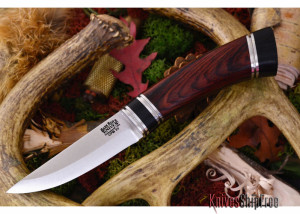
My Bark River Scandi came with a desert ironwood handle.
But everybody back then also carried a smaller knife. This was the do-all tool, used for everything from butchering livestock and wild game to serving as an eating utensil. In the Scandinavian countries, this small knife evolved into what is commonly referred to today as a “Scandi.”
By definition, these knives typically have a three-to-four-inch rigid blade, a generous handle with no guard and a Scandinavian-style grind.
I’ve used my C.T. Fischer four-inch Bushcrafter, another Scandi design, for several years. It sees service for small game processing and skinning around the neck and shoulders of deer and elk. It’s another keeper.
The BR Scandi came out last year, and I got one of the first on the market.
Here are the BR Scandi specs:
- Overall Length: 8.250 Inches
- Blade Length: 3.775 Inches
- Blade Steel: CPM3V @ 60rc
- Blade thickness: .145 inch
- Weight: 5.8 Ounces
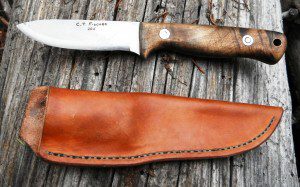
The C.T. Fischer four-inch Bushcraft knife comes with a custom leather sheath.
C.T. Fischer has a nice Scandi interpretation in his catalog, only he calls it a bushcraft knife.
Mine is a favorite small game knife, and it works very well with my flintlock rifle to harvest and process squirrels, rabbits and other small game in the fall. It is also light enough to be a good backpacking knife.
Specs:
- Overall Length: 8 1/2 inches
- Blade length: 4 inches
- Thickness: 3/32 inch
- Approximate Weight: 4.3 oz
- Blade steel: nichol alloy saw steel
Seax: Pronounced “sax,” the Seax is a design that goes back to the Middle Ages. It was an everyday, do-it-all knife that every peasant carried. The Saex was used for everything, from cutting fibers on the farm, to butchering livestock to cooking.
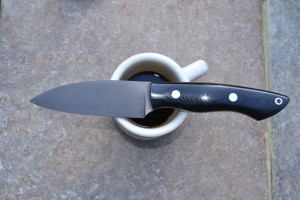
My Bark River Seax got a forced patina after the blade was stained with citric acid.
The BR Seax is massive. The handle is large, which is a good thing for a knife that might be used with gloves on. The blade thickness is about right for a utility knife.
The design grows on you. As is my custom, all new knives start out in the kitchen, and are used as needed for culinary work.
Well, it’s been several months, and the Seax is still on the knife rack. It will probably stay there. The Seax is used for any carving and slicing tasks that might come up, and it is particularly useful for cutting lemons, oranges and other citrus fruit.
This means the A-2 steel gets stained from the citric acid. That is no big deal – the blade got a forced vinegar/lemon juice patina, and it has that well-used look I find appealing.
I’ve heard that other Seax users swear by them for butchering and processing large animals. I’ll have to wait for hunting season to check that out!
Specifications
- Overall Length: 10.125 Inches
- Blade Length: 4.8 Inches
- Cutting Edge: 4.6 Inches
- Blade Steel: A-2 @ 58-60rc
- Blade Thickness: .187 Inch
- Weight:10 Ounces
- Made in the USA
Roach Belly: The historical Roach Belly knife was a short blade with a pronounced upswept curve and a sharp point. It might have been named after the Roach fish, which had a similarly round curving belly.The pattern was known in 17th century England and was quite common in the American Colonies because it was inexpensive and versatile. A roach belly was a go-to pattern back east and when the mountain men headed west to trap furs. The continued popularity of this design prove it works well.
My son Dan, a knife affectionado, could have had any knife he wanted from the KnivesShipFree.com catalog for Christmas. He chose the BR Hudson Bay Trade Knife. His reasoning was that the design looked like it would do everything he would need an all-around knife for. At some point soon, he’ll use the knife to field dress big game, and it will certainly earn its keep at camp.
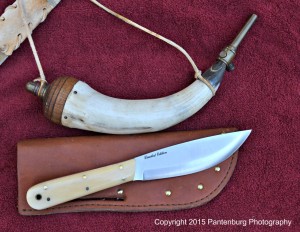
My son’s Hudson Bay Trade Knife and my favorite hunting powder horn match nicely.
Hudson Bay Trade Knife Specs:
- Overall Length: 9 Inches
- Blade Length: 5.5 Inches
- Cutting Edge : 5 Inches
- Blade Steel: A-2 Tool Steel @ 58-60rc
- Blade Thickness: .140 inch
- Blade Height: 1.7 Inches
- Weight: 5.675 Ounces
Hudson Bay Camp Knife II: The knife design dates back to the pre-Colonial days of the 1700s, according to the BR website. The Hudson Bay Trading Company was the dominant import/export company of early North America. The colonials, frontiersmen and trappers began to ask the Company for a larger knife to be used in base camp for general camp use. They wanted a heavy knife that would slice and chop in the place of a cleaver or an ax.
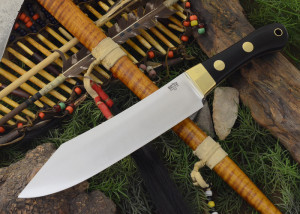
The BR Hudson Bay Camp Knife II is a backcountry workhorse.
You can work this knife hard, using it for everything from splitting kindling to butchering to cooking.
I got this knife with a black handle so it can blend in with the rest of the knives on the kitchen rack. It’s much easier to justify acquiring more knives to the significant other when those knives are used regularly in the house!
Specs:
- Overall Length: 14.63 Inches
- Blade Length: 9 Inches
- Blade Steel: A-2 @ 58-60rc
- Blade Thickness: .200 Inch
- Weight: 18 Ounces
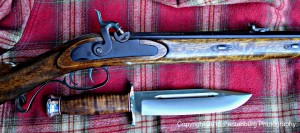
Think “Texas Rising” here. This Teddy II really goes well with my .50 caliber Lyman Great Plains blackpowder rifle.
Bowie knives had a role in the American conflicts of the nineteenth century. They are historically mentioned in the independence of Texas, in the Mexican War, the California gold rush, the civil strife in Kansas, the Civil War and later conflicts with the American Indians. John Brown (abolitionist) carried a Bowie (which was taken by J. E. B. Stuart). John Wilkes Booth, the assassin of Abraham Lincoln, dropped a large Bowie knife as he escaped.
The popularity of the Bowie knife declined late in the nineteenth century. Large caliber reliable revolvers were available by the mid-1870s, reducing a knife advantage. The frontier rapidly vanished, reducing the number of hunters and trappers. Large knives had limited utility, so Bowies shrunk.
My limited experience with the Bowie comes from one of my elk hunting buddies, Phil Walker. Phil, originally from Fort Worth, carried a Bowie in the backcountry and knew how to use it.
On opening day of elk season, 1993, Phil killed a six-point bull elk. He field dressed, skinned and quartered the big animal with his Bowie and a seven-in Old Hickory butcher knife, and packed it out to the pickup. All by himself. Phil, maybe 150 pounds soaking wet, also carried a Ruger Number 1 in .338 caliber. As always, skill trumps equipment.
Here’s the Teddy II specs:
- Overall Length: 13.375 Inches
- Blade Length: 8 Inches
- Cutting Edge Length: 7.5 Inches
- Blade Height: 1.625 Inches
- Blade Steel: A-2 @ 58-60rc
- Blade Thickness: .250 Inch
- Weight 17 Ounces
Nessmuk: George Washington Sears, 1821-1890, is better known by his pen name of “Nessmuk.” He wrote one of the first wilderness survival books, “Woodcraft,” in 1884 and was a regular contributor to “Forest and Stream Magazine.”
Sears had tuberculosis and the simple minimalist lifestyle in the wilderness appealed to him. Subsequently, Nessmuk wandered widely in various forests and wilderness areas, writing very popular stories for largely eastern audiences.
Nessmuk understood the importance of cutlery. His tools consisted of a custom light axe, a fixed blade knife he designed and a quality two-blade folding pocketknife.
The Nessmuk design is essentially a humpback skinning knife, and that’s what it works best for. The belly of the blade is just right for skinning large animals. I’ve heard the blade spine can be used to flesh a hide. And used upside down, edge up, the hump on the spine will keep the point from piercing intestines when gutting an animal.
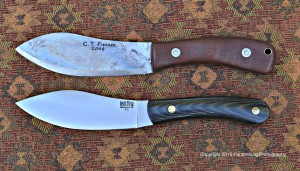
The C.T. Fischer, top, and the Bark River Nessmuks rely on a proven backcountry design.
Here’s the specs on the BR Nessmuk:
- Overall Length: 9″
- Blade Length: 4.75″
- Blade Thickness: .195″
- Blade Steel: A-2 @ 58-60 RC
- Weight: 8 oz.
C.T. Fischer: My first Nessmuk was made by C.T. Fischer. I got it a few years back, and it has been used extensively for a variety of cutting tasks.
Specs:
- Overall Length: 9 1/2 inches
- Thickness: 3/32 inch
- Approximate Weight: 6.2 oz
- Blade steel: Saw steel with a high nickle alloy, similar to L6
Kephart: Horace Kephart authored the classic two-volume set “Camping and Woodcraft” in the early 1900s.
But Kepart may be best remembered for a sheath knife design he popularized and used for many years. In an early edition of Camping and Woodcraft, Kephart described how the “knife of my own design” came to be:
“It was made by a country blacksmith, and is one of the homeliest things I ever saw; but it has outlived in my affections the score of other knives that I have used in competition with it, and has done more work than all of them put together.
The original Kephart had a four-inch blade, spear point and wooden handle. The blade was one-inch high and thin. Kephart made a leather sheath for his knife after the original wore out.
There are some great Kephart models on the market.
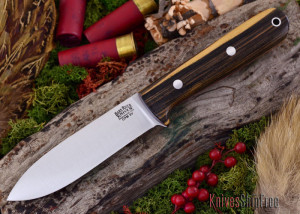
The BR Kephart comes in a variety of handle materials. The original Kephart had a plain wooden handle.
Bark River Kephart
Specs:
- Overall Length:8.775 Inches
- Blade Length: 4.250 Inches
- Cutting Edge: 4.1 Inches
- Blade Height: .775 Inch
- Blade Steel: CPM 3V @ 58-60rc
- Blade Thickness: .093 Inch
- Weight: 4.5 Ounces
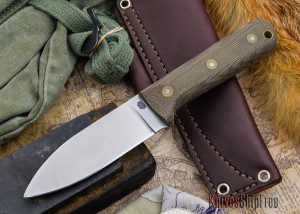
The L.T. Wright Genesis is based on the Kephart design.
L.T. Wright Genesis: I’ve used my Genesis for over a year, and it is flat-out handy for just about anything.
At a Women in the Outdoors Seminar I helped teach last year, the ladies had access to a bunch of my knives for firemaking and campfire cooking. The Genesis was very popular and got a lot of use.
Specs:
- Overall Length: 9″
- Sharpened Edge: 4.25″
- Steel: 1/8″ A2
- Grind: Flat Ground
- Other Features: Thumb scallops, 90° Spine
Lon Humphrey is a bladesmith and he hand forges every blade. While I haven’t used his Kephart, I did order a Sterling as soon as they came on the market. I liked it so much, I ordered another for my brother.
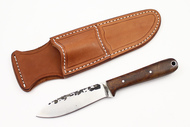
The Lon Humphrey Brute de Force Kephart follows traditional lines.
Here are the Brute de Force Kephart specifications:
- Overall length: Approximately 9″
- Blade Length: Approximately 4″”
- 1095 Carbon Steel at 57-58 HRC
- Thickness 3/16″
- Differentially heat treated for strength and edge retention
- Full exposed tang, stainless pins/lanyard tube
- 100% American made

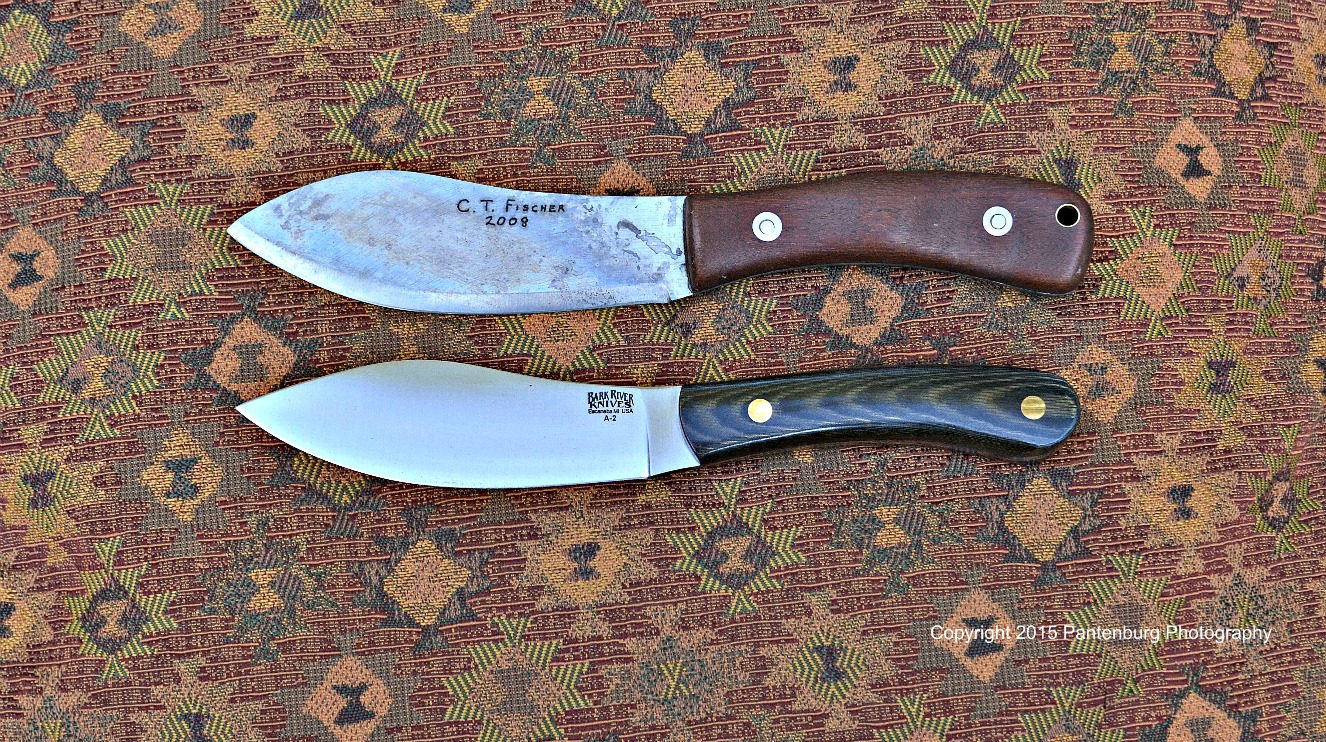
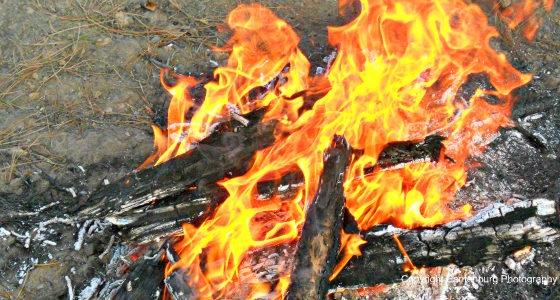
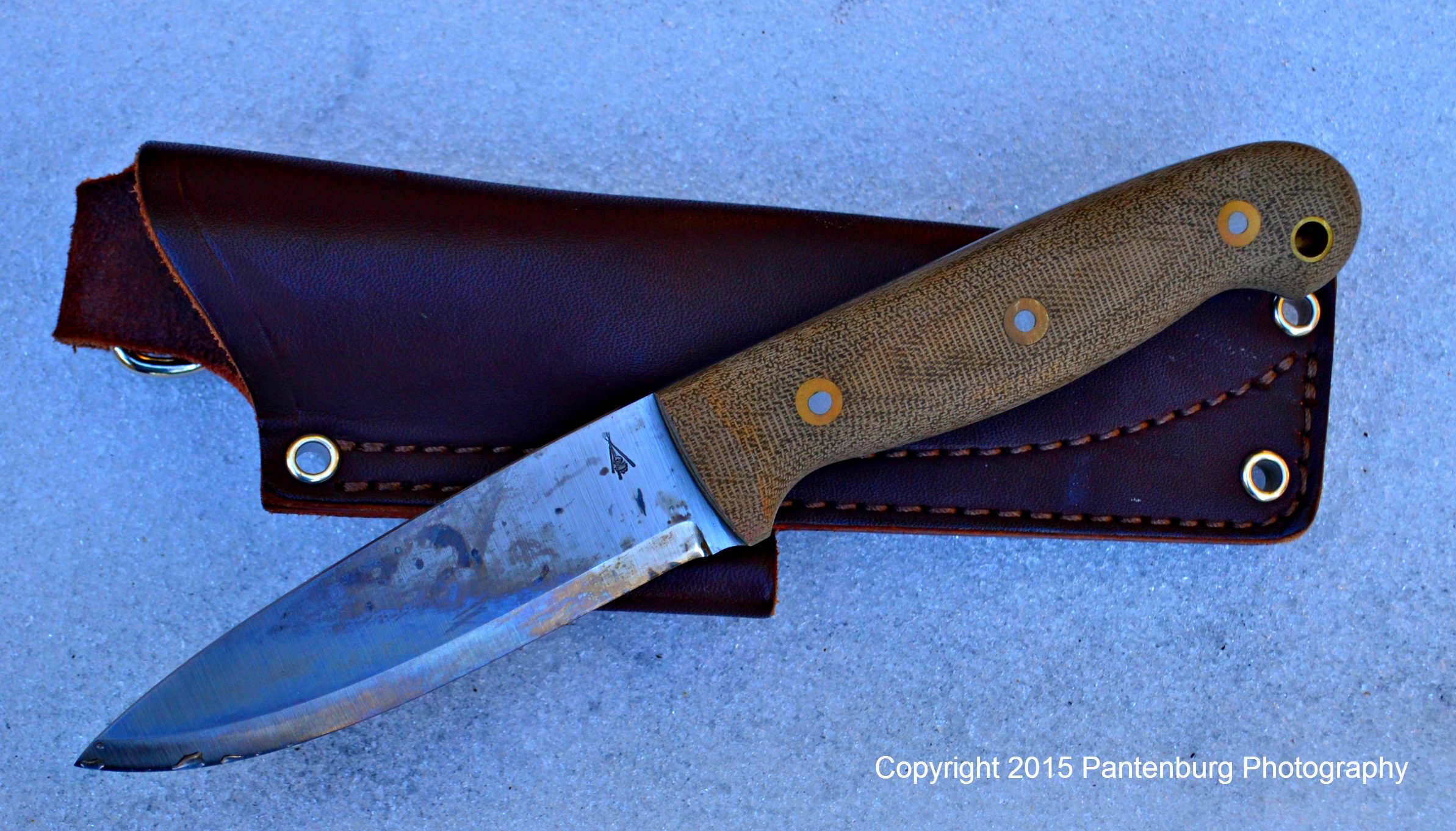

Leave a Reply